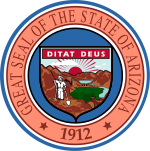Arizona State Capitol
1900 establishments in Arizona Territory1900s in Arizona TerritoryBuildings and structures in Phoenix, ArizonaGovernment buildings completed in 1900Government buildings in Arizona ... and 10 more
Government buildings on the National Register of Historic Places in ArizonaGovernment buildings with domesHistoric American Buildings Survey in ArizonaHistory museums in ArizonaJames Riely Gordon buildingsMuseums in Phoenix, ArizonaNational Register of Historic Places in Phoenix, ArizonaNeoclassical architecture in ArizonaState capitols in the United StatesTourist attractions in Phoenix, Arizona

The Arizona State Capitol in Phoenix, Arizona, United States, was the last home for Arizona's Territorial government, until Arizona became a state in 1912. Initially, all three branches of the new state government occupied the four floors of the statehouse. As the state expanded the branches relocated to adjacent buildings and additions. The 1901 portion of the Capitol is now maintained as the Arizona Capitol Museum with a focus on the history and culture of Arizona. The Arizona State Library, which occupied most of the 1938 addition until July 2017, re-opened in late 2018 as a part of the Arizona Capitol Museum.
Excerpt from the Wikipedia article Arizona State Capitol (License: CC BY-SA 3.0, Authors, Images).Arizona State Capitol
South 17th Avenue, Phoenix
Geographical coordinates (GPS) Address Nearby Places Show on map
Geographical coordinates (GPS)
| Latitude | Longitude |
|---|---|
| N 33.448055555556 ° | E -112.09638888889 ° |
Address
South 17th Avenue
85007 Phoenix
Arizona, United States
Open on Google Maps





